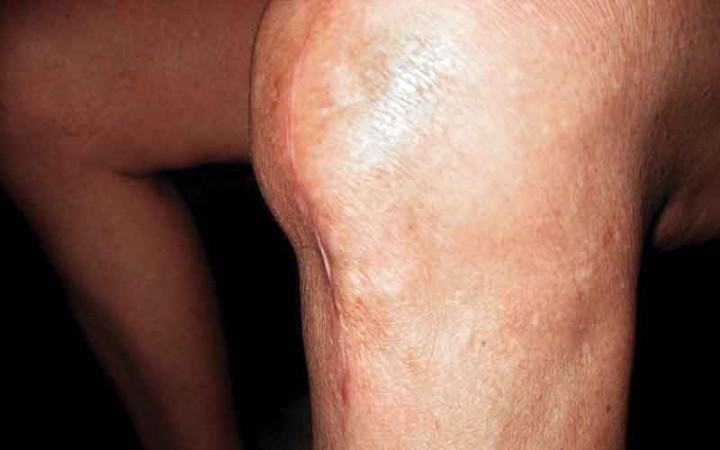VERO BEACH — The first time Debra LeBleu’s knee replacement popped out of position, the Vero Beach real estate agent was sitting at her desk in her office. She scooted her chair back to stand up and her knee cracked, popped and locked in position.
The top part protruded so far out, she couldn’t see the rest of her leg.
“The pain was excruciating, and it looked horrible and freaky,” said LeBleu, 55.
Two and a half years before in June 2007, she’d had a successful knee replacement – or so she thought.
She didn’t mind the seven-inch incision with 32 thick staples in her left leg. She didn’t mind the four months of recovery without an income.
Nor the giant centipede of a scar crawling down her leg.
She dutifully did all of the exercises – from flexing to knee bends – graduating from walker to cane to walking without a limp.
And the first time she made a complete revolution pedaling a bicycle, she whooped with joy.
“For a few years, I was so thankful,” she said.
As a knee cap recipient, Debra LeBleu is one of thousands of people in Vero Beach walking around with a metal knee cap.
Between Feb. 15, 2009, and Feb. 15, 2012, 2,014 knee replacement surgeries were performed at Indian River Medical Center – 10 percent of all IRMC surgeries.
According to Mayo Clinic statistics, about 600,000 knee replacements are performed in the U.S. a year.
Two percent of these appliances fail in the first five years, according to a 2009 article in the New England Journal of Medicine.
A very small percentage of these failures end up in court, as product liability lawsuits, as LeBleu’s has.
In December 2010, when her Journey knee, made by Smith & Nephew, popped out of place, her husband drove her to her orthopedic surgeon’s office and carried her in.
Orthopedic surgeon Richard Steinfeld, she said, told her part of the metal appliance had “jumped the post,” meaning that one of two metal pieces, cushioned with a thin layer of nylon, had separated from a small, stabilizing post, causing severe dislocation.
A very concerned Steinfeld told her, she said, that it was the first time he had seen that.
Steinfeld would not talk to sister publication Vero Beach 32963.
A few days later, Steinfeld cut into her knee and replaced the post, and, once again, LeBleu went through recovery, rehabilitation, physical therapy and, this time, only two months off work, without an income.
In April, 2011, four months later, while checking work e-mail, she shifted in her chair. Again, the cracking and popping. Again, the odd protrusion and excruciating pain. Again, her left leg frozen in place.
“Not again!” she screamed.
This time an ambulance took her to Indian River Medical Center’s emergency room. LeBleu recalled that when Steinfeld saw her, he was annoyed.
“Not at me but at the knee for dislocating again,” she said.
Steinfeld told her, she said, that he had notified the Smith & Nephew distributor, who said Smith & Nephew had a custom part to replace the post that didn’t work.
“Doesn’t having a custom part available for repairs suggest that the post problem is more than a rare occurrence?” asked Bob LeBleu, Debra’s husband.
Steinfeld answered the question, which Bob LeBleu now poses, in writing in LeBleu’s medical file, after her second dislocation: “She is here today following a 2nd left TKA (Total Knee Athroplasty) dislocation. I have been instructed by the manufacturer that this has become a recognized condition with the Journey implant and can be treated with a custom insert with a higher post to reduce the incidence of dislocation.”
The custom insert was delivered 12 days after the second dislocation occurred.
During that time, LeBleu was bedridden with a full brace on her left leg.
For the third time, she went through surgery and months of recovery and physical therapy, with no income.
But this time, she and her husband hired Miami attorney Sean Cleary to file a product liability lawsuit against Smith & Nephew, and the distributor.
A linchpin of the suit is what Steinfeld wrote in LeBleu’s file about the manufacturer instructing him that the dislocation was “a recognized condition with the Journey implant.”
“Dr. Steinfeld told me that the Smith & Nephew distributor said he knew of six or seven people with recent Journey knee dislocations in Florida,” said Debra LeBleu.
From the lawsuit: “Before Debra LeBleu’s initial surgery to implant the Journey (knee) and/or prior to the December 2010 and April 2011 failures involved in this case, Smith & Nephew … and/or other representatives had reason to know that the Journey (knee) and its component parts were defective, extremely dangerous, and unsafe for use by the general public for its intended purposes. Smith & Nephew … nonetheless apparently failed to take appropriate action to cure the defects or to appropriately warn users of the Journey (knee) and their physicians.”
Attorneys for Smith & Nephew, based in Memphis, Tenn., said they would not comment at this point in the lawsuit.
Meanwhile, Debra LeBleu has $150,000 to $200,000 in unpaid hospital and medical bills.
She said she wakes up in the middle of the night, with a biting sensation in her left knee.
It is warm to the touch, swollen and slightly discolored. When she stands, it pops and cracks, and moves sideways.
But, so far, the post has held for 10 months.
“Still,” she said, “I live in constant fear.”

